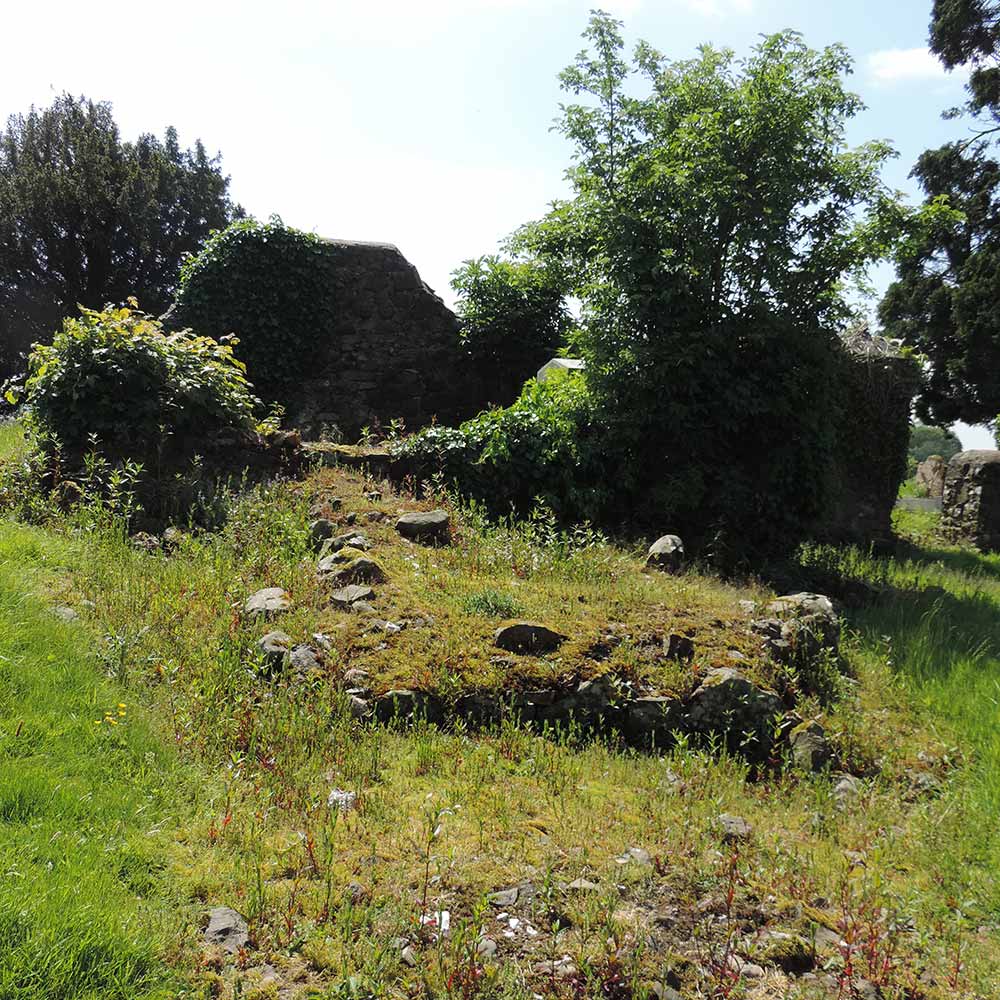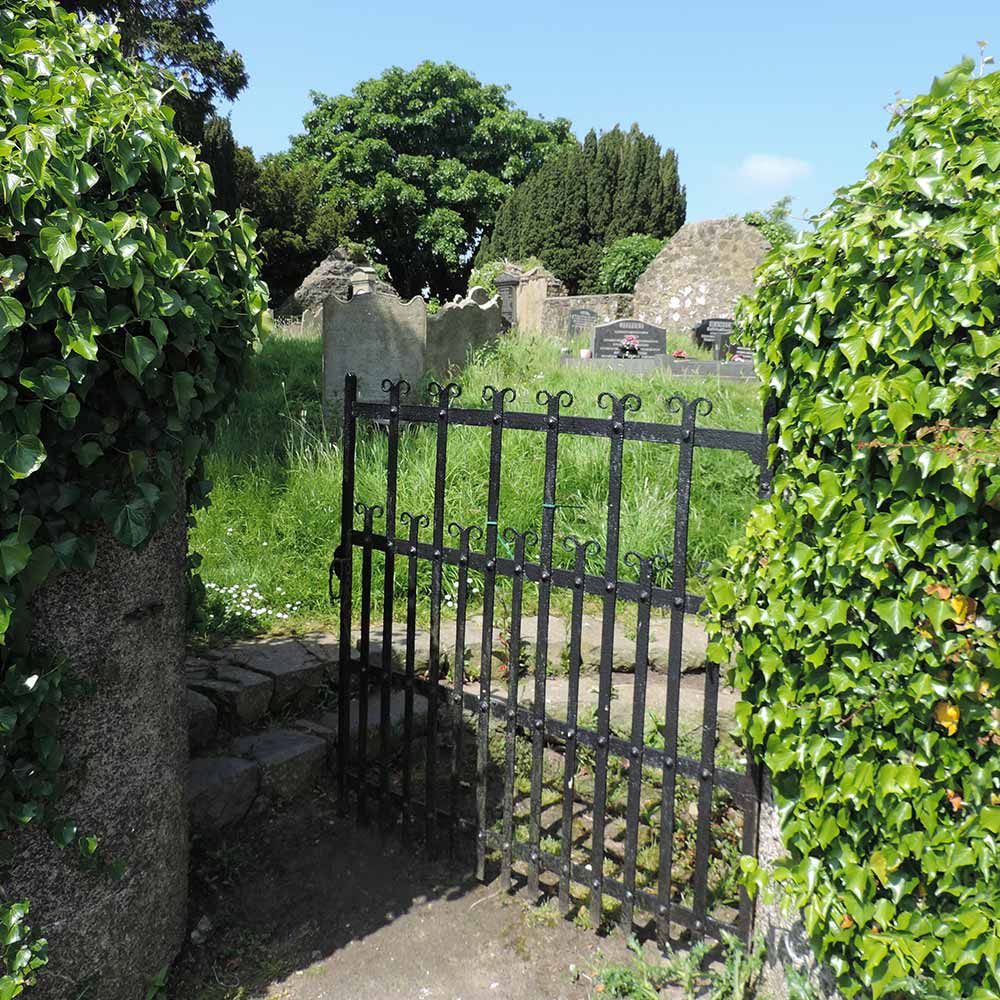(Tromraigh meaning ‘Place of the elder trees’)

From ancient times, Trummery may have been a resting place for travellers along the Slighe Miodhluachra – The High King's Road. It may be that Brian Boru and his army once rested here on their way to subdue to the Ulster chieftains at the Crew Hill, 1005AD.
The ruins of Magheramesk old church, thought to date from the late C12th or early C13th, can still be seen in the old cemetery on Trummery Lane. Francis McCorry suggests a church was founded here by St Bridgid, which could place it as early as C6th.
The site overlooks the railway line which was cut through the area in ????; and yet retains the features of a ringfort.
Mason’s Parochial Survey (1816) records an account of the destruction of the church, given by a former rector, Rev. Philip Fletcher …
"A strong stone house, standing where Trumry-house is now built, about 400 yards from the church, was occupied by a small party of Cromwell's soldiers to overawe the neighbouring country. To counteract this plan, a detachment of the Irish army took post in the church by night and were beginning to fortify themselves when they were attacked and dislodged by Cromwell's soldiers, who set fire to the church for this purpose."


Attached to the north-east corner of the church, there once stood a round tower. It is thought to have been built in the late 12th or early 13th century; at the same time as the church or shortly afterwards.

The tower was about 60ft tall and between 7-10 feet in diameter, with a cupola-shaped roof. A little below the roof, four windows looked out towards the four cardinal points of the compass.
Until the oak-beam which crossed the tower collapsed, it was known as the ‘bell-tree’ - a clue, perhaps, to the tower’s purpose!
As with similar towers, the exterior door was about 8-10 feet above ground level. It was then connected on the inside by a spiral staircase to a lower tunnel-like archway which led into the church.
Excavations carried out in 1842AD by Edmund Getty, Ballast Master of Belfast Harbour, revealed that the tower had been built on top of a burial sepulchre, in which human remains were found.
The demise of the tower, it would seem, was brought about by a series of unfortunate events … as described by a Mr John Rogan of Moira, in the Dublin Penny Journal (21st September, 1833).
He first describes how, around the time of the Ulster Rebellion (1641AD), troops from Soldierstown garrison or Inisloughlin Fort trained their cannons on the church ruins for target practice – in the process, damaging the exterior of the tower-wall.
The damage was gradually overgrown by ivy; but then, in the early C19th, the roots were cut and the ivy died and was torn off for fuel, thus loosening many of the stones.
Next, according to Mr Rogan, ‘These were beat out by mischievous boys, till the breach almost met round - yet a few straggling stones remained, struggling to support the mighty mass’.
Over time, many stones from the church and tower were plundered for use in local buildings, until eventually, in October 1828, ‘a thoughtless youth beat out the remaining supports’ … and the tower collapsed.
A slightly different account of the demise of Trummery tower tells of a group of farm labourers who took shelter in the tower during a sudden heavy shower of rain. They had just returned to their work in the potato-field when they heard a loud crash, and looked round just in time to see the dust settling over a heap of rubble.
The tower is also said to have been the haunt of a notorious robber, Count Redmond O’Hanlon.
The ford of Inisloughlin, about two miles south of Trummery, has long occupied one of the most strategic locations in the north of Ireland - where the Slighe Miodhluachra (the High King’s Road) crossed the river Lagan. Following the Battle of Moira, the area was held by the O’Neills for several centuries, during which a fort was built to defend the crossing and the pass of Kilwarlin.
During the Nine Years War (1593-1603), the fort and the surrounding woods of Killultagh provided a secure base for the Gaelic forces of Hugh O’Neill. Recognising the strategic importance of Inisloughlin, Sir Arthur Chichester along with Sir Hugh Davers led a force to besiege it, and the fort was surrendered on 10th August 1602.
Inisloughlin fort was the base for Crown forces involved in the Battle of Lisnagarvey 1641AD.
Rev O’Laverty records that, ‘The farmer who occupied the farm on which it stood, filled up its intrenchments, and left only a small fragment of the castle standing. Many cannon balls, some antique gold rings and other objects, were found during the operations.’
In 2008, a team from the Centre for Archaeological Fieldwork (Queen’s University, Belfast), led by Philip MacDonald, excavated a site close to Spencer’s Bridge and concluded that it is almost certainly the site of the Gaelic fort of Inisloughlin. However, the site was found to be relatively poorly preserved and further excavation seems neither likely nor worthwhile.
Captain Henry Spencer, after whom Spencer’s Bridge is named, was governor of Inisloughlin Fort from 1605. It is believed that he was granted four square miles of land under Queen Elizabeth I, but from 1623 he seems to have held a 95-year lease on 2500 acres in Killultagh from Lord Conway.
Around 1625, it seems that he built the ‘strong stone house’ mentioned above; but later, in 1652, erected the Trummery House.

Trummery House remained in the Spencer family until 1728 when it passed into the possession of the Bell family, a prominent local Quaker family. It is known, within living memory, that there was a well in the cellar; and is thought that there was also an escape tunnel leading into the fields towards the river. Some years ago Trummery House was demolished and a more modern house now stands on the site.
The details of the family tree of the Spencers of Trummery seem inconsistent. There are at least three, possibly four, Brent’s in different generations:
It is believed locally that the Spencers of Trummery were related to the those of Althorp from whom the Earls of Sunderland, Earls of Spencer, Winston Churchill and Princess Diana were all descended. It is also believed that a Captain Earl Spencer entertained his aunt, Sarah Churchill, Duchess of Marlborough, at Trummery House after she fell out of favour with Queen Anne and was dismissed from court (circa 1710AD). Unfortunately, our research has so far been unable to establish the family link or to find sufficient historical evidence to support these theories – if any reader can help, please let us know!
Half way between Trummery and Inisloughlin, there is an ancient Holy Well called Tober Dooney (Tobar (an) Domhnaigh) meaning 'Sunday's well', a well that was traditionally visited on Sundays. Coincidentally, the well is located adjacent to the Baptist Training Centre.
Over the years, many historic artefacts have been unearthed in Magheramesk and, indeed, throughout the parish - including megalithic tombs and ancient burial grounds, ancient urns, coins of various age, viking smoking-pipes, pottery from the middle-ages, a medieval gold gorget and several lunettes, many cannon-balls and even Saint Patrick's Footstone!
